The vivarium tank requires little maintenance. However, a proper daily vivarium tank maintenance routine will help you in the long run. This article will address what is a bioactive vivarium and how to build it. After that, 2 sections are devoted to different aspects of maintaining a bioactive vivarium.
Content Table
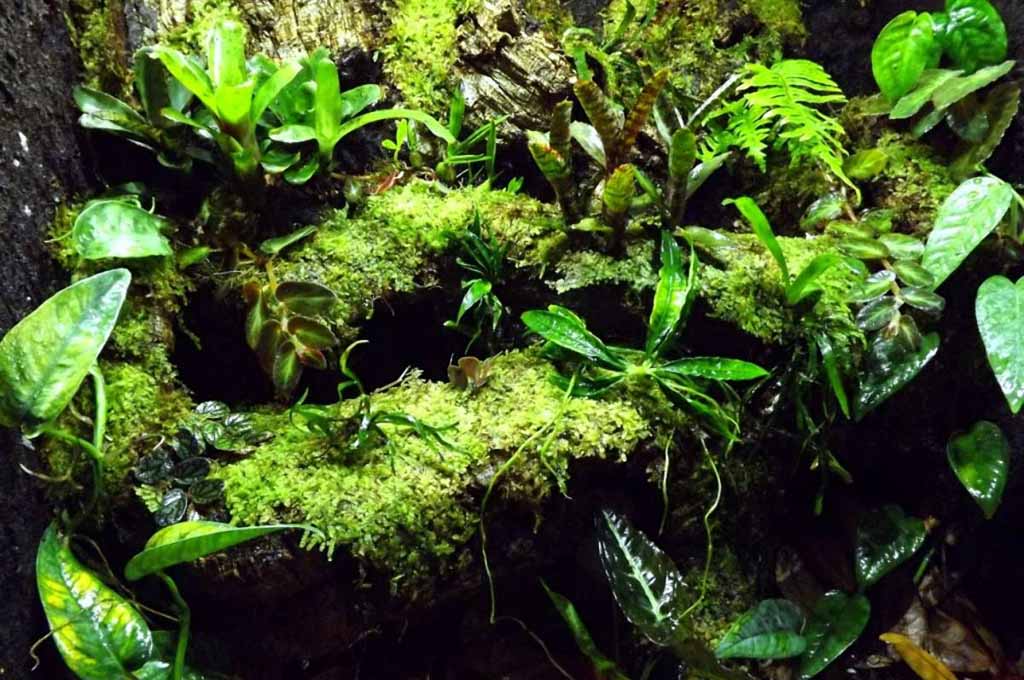
Vivarium tank maintenance
Bioactive Vivarium Tank
A bioactive vivarium is a tank that creates a part of the original ecosystem to offer a self-sustained life. It includes all-natural parameters of that ecosystem, i.e., temperature, humidity, substrate, plant, etc. It has a live substrate to support the natural plants, microorganisms, and invertebrates. These things help to break down animal waste and create a balanced environment in the enclosure.
Characteristics
Bioactive vivarium tanks are different from other general enclosures. Here are some key characteristics of this ecosystem.
| It has a live substrate with all original ecosystem-beneficial microorganisms. | It has small invertebrates that help to break down the pet waste. | Requires less maintenance.
|
| It has the environment’s original flora. | It has a balanced ecosystem. | Full-spectrum lights are another property that replicates natural sunlight. |
| Its hardscape elements, i.e., rocks, driftwood, barks, etc., give it a more realistic look and self-sustainability. | ||
Building Tips
Here are some building tips that will give you an idea about how to build a bio-active vivarium. For the sake of ease, I’ll break it down into multiple parts.
Layering
Layering is among the primary aspects of building a vivarium. It decides the stability and life of a vivarium. Layering includes a drainage layer, a screen separator, a substrate layer, and leaf litter.
| Layer | Purpose | Building Material | Building Tip |
| Drainage Layer | It rejects the extra water from the tank and avoids waterlogged conditions. | LECA, Hydroballs, Bio Drain, NEHERP LDL | Ensure water rises 1/4-1/2 way up the layer. Use a siphon or bulkhead fitting for water removal |
| Screen Separator | It separates the drainage layer from the rest of the system and helps water and air circulation. It also serves as a house for microorganisms | Non-toxic fine screen mesh, weed-blocking material. | Just lay it over the drainage layer properly. |
| Substrate Layer | Along with supporting the structure, it supports plant growth and provides them with essential nutrients. | ABG mix (tree fern fiber, peat, charcoal, sphagnum, orchid bark) or NEHERP mix (with coconut fiber) | Although laying the sphagnum layer is optional, it helps maintain cleanliness. |
| Leaf Litter & Ground Cover | It serves as a hiding spot to support microorganisms and helps to improve the nutrient cycle. | Leaf litter, moss, and small plants | Often replace this layer as it is the most exposed layer and faces more wear and tear. |
Hardscaping
It enhances the aesthetics and provides a climbing surface for plants and pets. You can use an already prepared background along with custom development. Polyurethane foam, silicon, concrete, and faux-rock are some custom development materials.
Wood is used for hardscaping. On selecting a wood, ensure that your wood is safe in water conditions and matches the vivarium’s condition. Mopani, cork, ghost wood, manzanita, and Malaysian driftwood are hardscaping options.
Plant
Remember the size, growth rate, required parameters, and suitability with pets and vivarium conditions while selecting a plant for your vivarium. Sanitize the plant before introduction in the tank. Keep your plant continually moist during acclimation. It will speed up the procedure.
Lighting
Lighting is another salient vivarium-building feature. 5000-6500K spectrum lights do well for the vivarium setup. Light size and duration usually depend on tank size.
Other Building Tips
- A removable glass lid helps to maintain the humidity level in the vivarium.
- Use suitable microfauna, i.e., springtails and woodlice, to break down decaying material. It helps to maintain a bioactive vivarium.
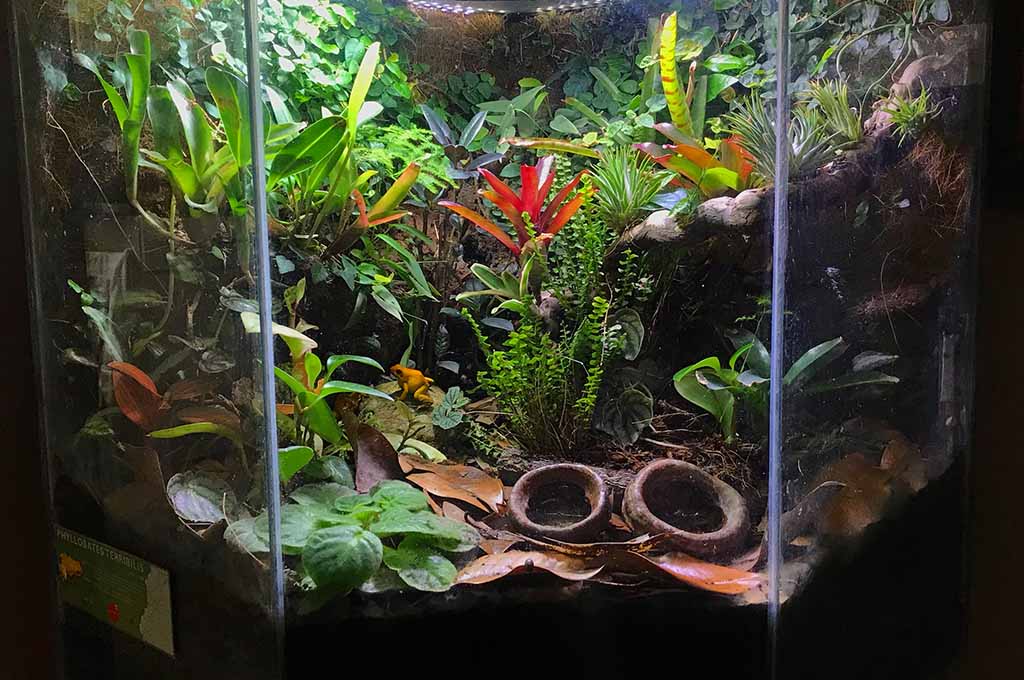
Vivarium Tank
Advice for Maintaining a Bioactive Vivarium
Vivarium tank maintenance requires multiple aspects. Here are some primary maintenance categories.
| General maintenance | Water management |
| Plant maintenance | Animal care |
| Environmental factor management | |
General maintenance
Here are some primary aspects to keep on thriving and lush your vivarium.
- Keep on regularly checking temperature, humidity, and light levels. Maintain them within the optimal range.
- Periodically change the leaf litter to maintain the nutrient cycle in the tank. Also, make sure that it remains moist. However, avoid waterlogged conditions.
- Maintain a proper microfauna population as they break down the waste and improve the aeration.
Plant maintenance
- Ensure proper pruning to keep them in shape. Pruning also promotes bushy and healthy growth.
- Use liquid fertilizer for equal nutrient distribution. It’ll promote the desired growth rate.
- Grow various plants for different colors in different seasons, and always keep your vivarium tank.
- Usually, all vivarium plants grow well under sunlight. Therefore, install a sunlight spectrum LED light with a proper day-night cycle.
Animal Care
- Remove the uneaten food for any potential threat of pets or molds.
- Do spot cleaning after animal feces. Do it in such a fashion that it doesn’t disturb the ecosystem.
Water Maintenance
- Ensure that the drainage line is working effectively. Avoid choking or leaking, as it can cause waterlogged conditions in the vivarium.
- Maintain proper humidity to provide pets with natural environmental conditions.
Environmental Enrichment
- Maintain the vivarium by cleaning the pits and hiding spots regularly, as pets love to hide themselves.
Disease Management
- Daily inspection of every vivarium aspect for disease or pests.
- Quarantine every plant and pet before introducing them into the tank to avoid potential threats.
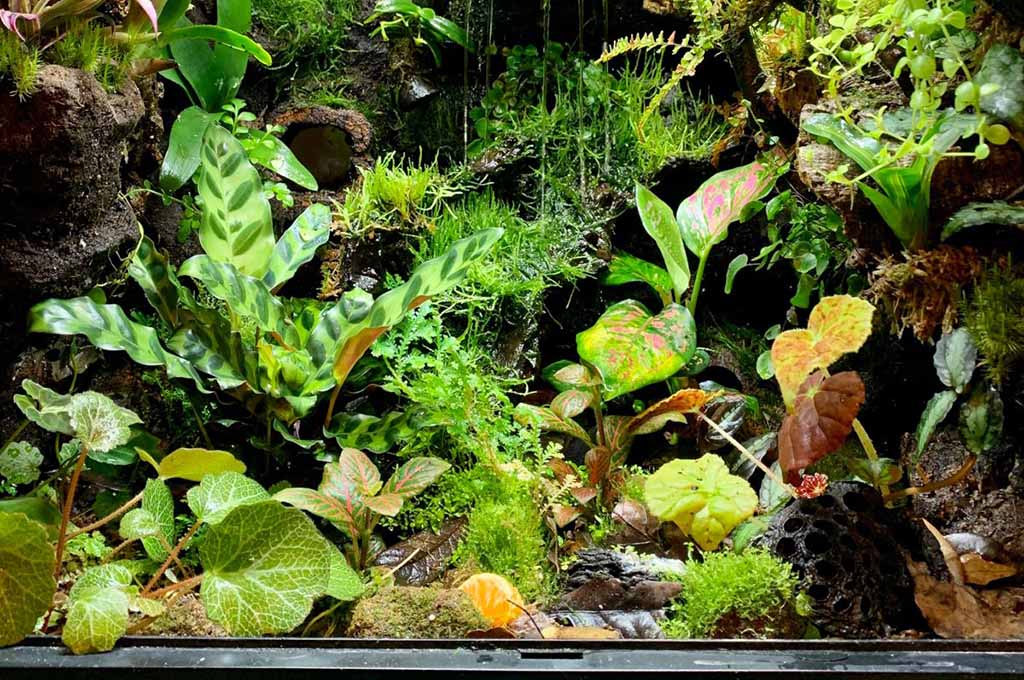
Maintain a bioactive vivarium
Tips for Vivarium Tank Maintenance
Here are some tips to maintain a bioactive vivarium in optimal condition.
Adding Flowing Water
- Regularly check and maintain the water pump.
- Always use dechlorinated and distilled water with optimal parameters.
- Water and algae are relative. If you have a water area in your vivarium, you can add shrimps and snails to control the algae growth.
- Maintain such a flow that matches with exact natural conditions.
Introduction of Live Plants
- Select the plant according to the temperature, humidity, and lighting conditions of the vivarium.
- Acclimate the plants before introducing them into the vivarium.
- While planting, plant your plant into nutrient-rich substrate. Ensure that the root is fully covered.
- Water them regularly with dechlorinated water and also mist them.
- Ensure the proper sunlight spectrum, i.e., 3 to 5 V. You can achieve it with the help of LED lights.
- To ensure bushy growth and healthy growth, regularly prune your plants. Remove decayed, decaying, or dead plants immediately.
Driftwood Maintenance
- Driftwood is used in the vivarium to create a naturalistic look and a hiding spot for pets. Choose the right driftwood before building a vivarium. Here are some maintenance tips regarding driftwood.
- Boil or soak the driftwood in hot water before introduction. It helps to remove pests and tannins from it.
- Use adhesive to secure the driftwood into the vivarium to avoid its mobilization.
- Mold and fungus badly affect it. Therefore, regularly watch it. If you find any such thing, remove it earlier.
- For cleaning, use a soft-bristle brush and gently scrub the surface. Remember, never use soap or chemicals, i.e., they are harmful.
Some Other Tips
- For better observation, regularly clean the glass surface with a vinegar solution, i.e., it’s a vivarium safe.
- Frequently change the leaf litter layer.
- Maintain the microfauna level in the tank.
- Stir the substrate to avoid stiffness.
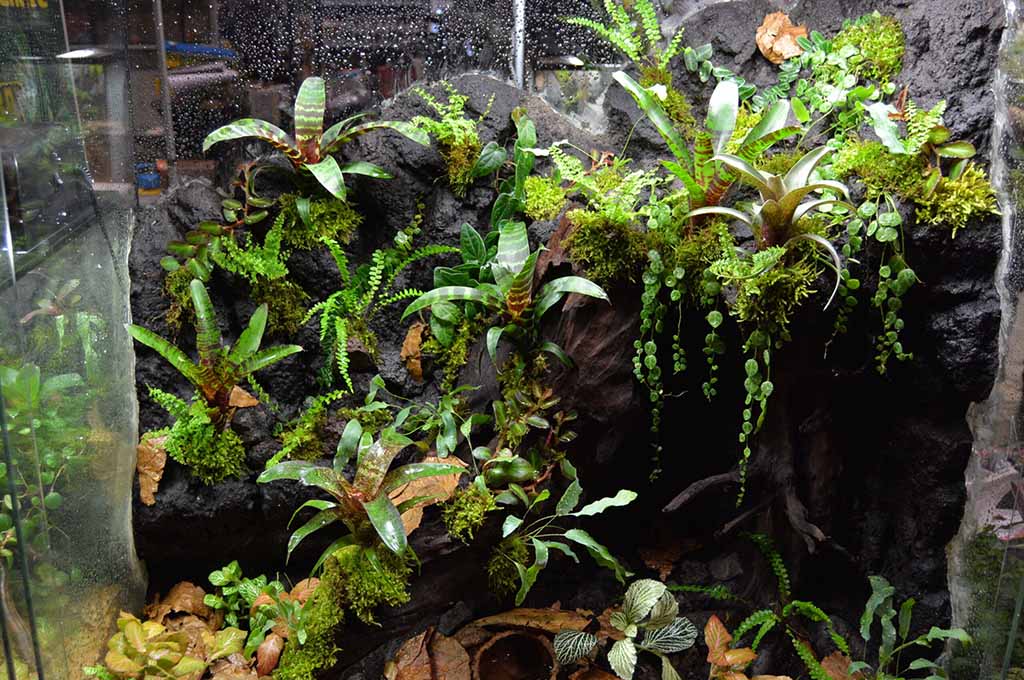
Daily vivarium tank maintenance
Keep an Eye on the Vivarium Tank Plants and Woods
Plants and wood help to create a specific design in a vivarium tank. Therefore, you need to be very specific in vivarium tank maintenance. Here are some tips to maintain bioactive vivarium plants.
- Remove dying leaves from the plant.
- Maintain higher humidity in the tank on the new plantation.
- Install the lighting that matches your plant requirements.
- Use ABG substrate for proper plant growth. You can make it as follows
| 2 parts tree fern fiber | 1 part peat moss | 1 part charcoal | 1 par sphagnum moss | 2 parts fir bark |
Wood Maintenance
- Use a clean and damp rag to clean the new wood surface.
- Use dry paper for drying.
- Disinfect the wood surface with a disinfectant solution
- Air dry it.
- Lay an aluminum foil under the wood in the vivarium to save it from moisture.
To Sum Up
Vivarium tank maintenance involves numerous aspects. You’ve learned its characteristics and how to build it. Some advice regarding general, plant, water, animal, and environmental factors maintenance is also part of the discussion. Some maintenance tips for bioactive vivariums regarding flowing water addition, plants, and driftwood are also part of it.
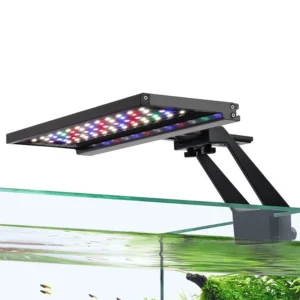
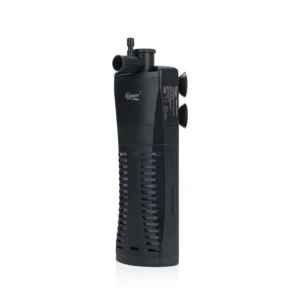
Leave a comment